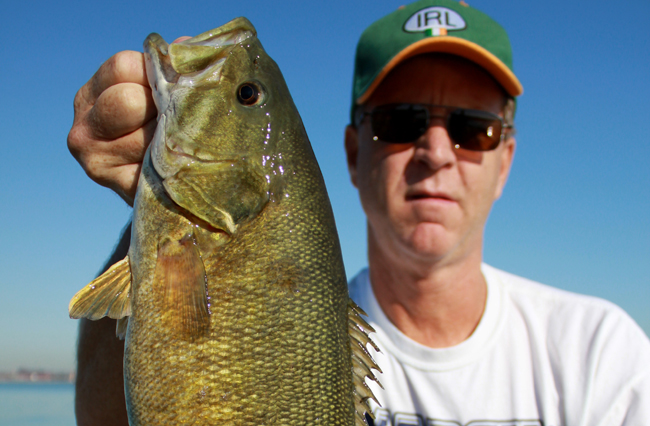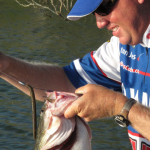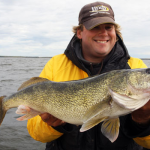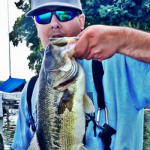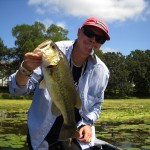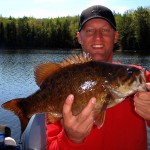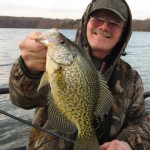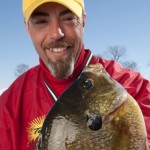By: Andrew Ragas
Smallmouth bass are arguably one of the most fun and sporting fish to catch, and personally one of my favorites. They are historically native to most rivers and streams in Illinois. Within the last quarter century their self-sustaining populations have been established in some of our inland bodies of water to offer additional angling opportunities.
Amongst the most popular fishing destinations found throughout our state, and regarded as one of the best in the entire Midwest region, the southern basin of Lake Michigan offers world class fishing opportunities for smallmouth bass. The big lake, in particular, is no stranger to the re-establishment of fish species and population restorations.

Historically speaking, smallmouth bass are native to several confined regions of Lake Michigan, but very few of them were found in the southern basin of Lake Michigan prior to 1996. Their once-limited populations in Illinois waters inhabited the restricted off-shore reefs and shoal areas for several years before heavy stocking efforts began taking place within Chicago’s city limits.
From 1969 through 1985, approximately 101,706 juvenile smallmouth bass were sporadically stocked in a few select sites around Chicago. Years later during the late 1980’s and early 1990’s, it became evident to state biologists and anglers that these limited stockings had generated into small, self-sustainable populations, and resurrected the native smallmouth bass fishery.
Since then, the Illinois Department of Natural Resources has supplemented these original ancestors with additional stockings that were dispersed along much of the lakefront. These efforts have consequently resulted in a self-sustaining world class fishery right in the heart of Chicago and the surrounding southern basin of Lake Michigan. Presently the populations are thriving, with stocking having being discontinued more than a decade ago.
Southern Lake Michigan is notoriously known as a shallow water environment with very little natural structure and a bottom composition of nothing more than sand. However, as local municipalities and industries began to gradually develop the shoreline by constructing parks, piers, beaches, boat slips, and break walls, the coast was transformed into ideal smallmouth bass habitat.

Today’s habitat and favorite angling areas are all man-made, comprised of rocky rip-rap and boulders lining the shorelines, breakwalls, rock reefs, harbors and additional boat slips. Almost immediately, smallmouth bass began utilizing these areas claiming the territory as their own.
Smallmouth bass are caught from several near-shore and off-shore areas of Lake Michigan. Most anglers who fish the Chicago area of the lake fish from shore and harbor hop, while others work by boat and comb the break walls. Throughout the spring and summer months, when most of the fish are shallow and active, the fishing peaks.
One angler in particular who has made a name for himself by fishing Lake Michigan since his formative years is Captain Ralph Steiger.
Steiger, 26, of Hammond, IN, guides and charters the southern basin of Lake Michigan on a year-round basis out of his 2011 model Crestliner Tournament 202WT, and suggests that the smallmouth bass fishing is as good as it can be from spring through summer.

According to Captain Steiger, who has guided for six years, the early spring through summer period is comprised of several movements, and stages, all of which are related to the spawn. He suggests a few key depth ranges for anglers to concentrate on.
“In the early spring, as water temperatures are between 45 to 55 degrees and get warmer, I tend to look for fish in deeper water, anywhere from 12 to 25 ft. Then as spring progresses into summer, water temperatures warm, and the fish move in for the spawn, they can hold as shallow as 4 feet. On average I would say an 8 to 12 ft. depth range is perfect.”
As far as structure and habitat locations are concerned, one of Captain Steiger’s favorite focal points is transition areas. Examples are sharp drop-offs where rock and sand meet. Captain Steiger states, “Smallmouth early in the year use these sharper contours and the rock/sand bottom prior to invading the shallows. As the summer season arrives it is important to work these same areas but to concentrate your efforts in shallower water.”
Captain Steiger points out that rock and steel walls will both frequently hold fish but in order to have success, anglers must experiment in order to find which is best for the given time of year. In addition, warm water discharges may hold numbers of fish but due to heavy recreational pressure these areas can be a feast or famine.
Following the spawn, Captain Steiger notes that “Fishing can become difficult during the few weeks after, but once the fish resume in a summer pattern they become easier to catch again.” He adds, “The best areas to target are going to have sharp drop-offs, usually with large rocks. It is important that you don’t move far off from the areas in which fish were spawning, but just look for the sharper and deeper shorelines.”
In addition to spawning, most of the smallmouth population will also be utilizing the shallow water taking advantage of the abundant food sources. Luckily for them, there is no shortage of good available habitat. On Lake Michigan, in particular, it seems as if anywhere there are rocks placed, fish will be present.
In order to rear a healthy fishery that possesses both numbers and sizes of fish, there needs to be a diverse and abundant available food source. Lake Michigan’s smallmouth bass have several options that they use at different times of the year. As the seasons change, different prey species become more available, and turn into the preferred dinner menu item.
One of the most abundant and frequent spring and summer forage species is the invasive round goby. These small, 2 to 4 inch bottom-dwelling fish lack a swim bladder and are always confined to the lake’s bottom, utilizing the same rock habitat as the smallmouth.
Several tackle manufacturers have created goby imitation tubes and plastics to match the hatch. When fished properly, the goby imitating plastic is deadly.
One of Captain Steiger’s all-around favorites is the Poor Boy’s Erie Darter, a simple do-nothing type of flapper-tail plastic that is best served on a jig to hop and drag along the bottom. “The presence of gobies is like having a 24 hour buffet in front of them,” he claims.
For Captain Steiger and many of his clients, Poor Boy’s Erie Darters are his baits of choice most of the time. For instance, “They are easy to fish, don’t cost a lot (which is good for the numerous snags), and work great.” Captain Steiger interestingly notes, “There are several goby imitators out there and some of them work while others don’t. It seems like the more detail the bait companies put into copying a goby the worse they work. Certain companies are investing too much time into cosmetics and not enough time into recreating the movement of a goby.”

When fishing the Poor Boy Darter, Captain Steiger warns “It’s appearance underwater isn’t too overwhelming with action. Fished best when rigged with a 1/8 oz. to 3/8 oz. jig head, it is meant to be fished and hopped along the bottom without much action.” He believes that for these reasons singlehandedly, the Darter works so well and imitates the real thing. For the all-around plastics approach, some of the more popular color choices for Lake Michigan are brown, green pumpkin, smoke, purple, and red with variations of these colors mixed together with gold or black flecks
Captain Steiger claims that due to the several forage options for smallmouth bass, it is important to match the hatch accordingly. “In early spring mimic shad, shiners, smelt and alewives. In later spring thru early fall mimic gobies. In later fall both patterns can work at any time. Keep it simple and you will catch fish.”
As far as gear and tackle is concerned, medium light to medium heavy action rods between the lengths of 6 ½ to 7 ½ ft. are preferred. 8 to 10 lb. main line is standard but due to the zebra mussel infestations and razor-sharp abrasive conditions it is important to use 10 to 15 lb. fluorocarbon leader material to help prevent line frays and break-offs.
Essentially, smallmouth bass are caught all along Chicago’s lakefront and extending all the way down to Northern Indiana. Some popular areas for smallmouth bass angling in the Chicago area are around several of the city’s landmarks. All of the downtown harbors offer shoreline and boat access to fish, including the Chicago River, as does the area surrounding Navy Pier and the treatment plant, and the museum campus. However, for Captain Steiger, “Some of the best areas to fish out of are East Chicago Marina, Hammond Marina, or Burnham Harbor. There are plenty of fish around these locations whether you go from shore or boat.”

Nowadays, most of the smallmouth bass caught range in size from 10 to 14 inches, but there are significant numbers of larger fish out there. Bass in the 2 pound range are most common, while 3 pounders aren’t too far behind. There are also 4 and 5 pound fish available throughout the warm weather months, including the 5 lb. 12 oz. brute that was caught and released by Captain Steiger a few years ago. It is possible that the next state record is out there somewhere.

With great angling comes conservation-minded principles that help elevate the fishing to world class proportions. In 1998, a mandatory catch and release program, which still exists, was enacted so that smallmouth bass populations can grow and expand to the high levels that we have today. With state record size fish being caught and released within six years of the rule being established, changes were made in 2004 to accommodate the possible harvest of the next state record size fish. However, nearly everything goes back, and catch & release is widely followed regardless of circumstances. These days, the smallmouth bass fishing on Lake Michigan is better than ever. To help keep it that way, it is important to handle fish carefully and to practice catch-and-release as if it were a religion.
During an era in which state enforcement is few and far between, Captain Steiger and majority of the city’s harbor hoppers serve as stewards of the lake, and help promote and mandate the conservation required to sustain a high class fishery. Steiger stresses, “Something that most common anglers don’t realize is that the DNR doesn’t stock any of these fish because they are all naturally reproducing. For every fish people keep another will never be stocked to replace it. It is critical that catch and release be used 100% of the time. We have a great thing happening here and if we don’t protect it we have no one to blame but ourselves.”
Captain Ralph Steiger specializes in guide charter trips on Lake Michigan for smallmouth bass, salmon and trout, and perch from Chicago, Illinois to Hammond, Indiana. To book your trip, you may reach him at (219) 688-3593, or at ralphish00@aol.com. Visit him online at http://www.captainsteiger.com


